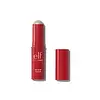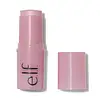What's inside
What's inside
 Key Ingredients
Key Ingredients

 Benefits
Benefits

 Concerns
Concerns

 Ingredients Side-by-side
Ingredients Side-by-side

Pentaerythrityl Tetraisostearate
EmollientDicaprylyl Carbonate
EmollientDiisostearyl Malate
EmollientBis-Diglyceryl Polyacyladipate-2
EmollientOzokerite
Emulsion StabilisingEthylhexyl Palmitate
EmollientMica
Cosmetic ColorantCocos Nucifera Oil
MaskingSynthetic Wax
AbrasivePolyisobutene
Tocopheryl Acetate
AntioxidantParfum
MaskingEthylhexylglycerin
Skin ConditioningPrunus Amygdalus Dulcis Oil
Skin ConditioningTin Oxide
AbrasiveRosa Rubiginosa Seed Oil
EmollientTocopherol
AntioxidantWater
Skin ConditioningButylene Glycol
HumectantPhenoxyethanol
PreservativeCitrullus Lanatus Fruit Extract
Skin ConditioningCitral
PerfumingLimonene
PerfumingHydroxycitronellal
PerfumingLinalool
PerfumingCI 77891
Cosmetic ColorantCI 77491
Cosmetic ColorantCI 77499
Cosmetic ColorantCI 77492
Cosmetic ColorantPentaerythrityl Tetraisostearate, Dicaprylyl Carbonate, Diisostearyl Malate, Bis-Diglyceryl Polyacyladipate-2, Ozokerite, Ethylhexyl Palmitate, Mica, Cocos Nucifera Oil, Synthetic Wax, Polyisobutene, Tocopheryl Acetate, Parfum, Ethylhexylglycerin, Prunus Amygdalus Dulcis Oil, Tin Oxide, Rosa Rubiginosa Seed Oil, Tocopherol, Water, Butylene Glycol, Phenoxyethanol, Citrullus Lanatus Fruit Extract, Citral, Limonene, Hydroxycitronellal, Linalool, CI 77891, CI 77491, CI 77499, CI 77492
Propylene Glycol
HumectantWater
Skin ConditioningBis-PEG-18 Methyl Ether Dimethyl Silane
EmollientSodium Stearate
CleansingGlycerin
HumectantSynthetic Fluorphlogopite
Magnesium Aluminum Silicate
AbsorbentPunica Granatum Fruit Extract
AntioxidantButyrospermum Parkii Butter
Skin ConditioningTocopheryl Acetate
AntioxidantTheobroma Cacao Seed Butter
EmollientButylene Glycol
HumectantPEG-40 Hydrogenated Castor Oil
EmulsifyingTin Oxide
AbrasiveEthylhexylglycerin
Skin ConditioningSodium Chloride
MaskingCitric Acid
BufferingPhenoxyethanol
PreservativeParfum
MaskingLinalool
PerfumingCI 77891
Cosmetic ColorantCI 77491
Cosmetic ColorantCI 16035
Cosmetic ColorantPropylene Glycol, Water, Bis-PEG-18 Methyl Ether Dimethyl Silane, Sodium Stearate, Glycerin, Synthetic Fluorphlogopite, Magnesium Aluminum Silicate, Punica Granatum Fruit Extract, Butyrospermum Parkii Butter, Tocopheryl Acetate, Theobroma Cacao Seed Butter, Butylene Glycol, PEG-40 Hydrogenated Castor Oil, Tin Oxide, Ethylhexylglycerin, Sodium Chloride, Citric Acid, Phenoxyethanol, Parfum, Linalool, CI 77891, CI 77491, CI 16035
 Reviews
Reviews

Ingredients Explained
These ingredients are found in both products.
Ingredients higher up in an ingredient list are typically present in a larger amount.
Butylene Glycol (or BG) is used within cosmetic products for a few different reasons:
Overall, Butylene Glycol is a safe and well-rounded ingredient that works well with other ingredients.
Though this ingredient works well with most skin types, some people with sensitive skin may experience a reaction such as allergic rashes, closed comedones, or itchiness.
Learn more about Butylene GlycolCi 77491 is also hydrated iron III oxide. It's sole purpose is to give a red/pink hue to products.
Iron III oxides are classified as inorganic chemicals for coloring.
Synthetically created Ci 77491 is considered safer than those naturally found. This is because the synthetically created version may contain less impurities. Iron oxides are generally non-toxic and non-allergenic.
Learn more about CI 77491Ci 77891 is a white pigment from Titanium dioxide. It is naturally found in minerals such as rutile and ilmenite.
It's main function is to add a white color to cosmetics. It can also be mixed with other colors to create different shades.
Ci 77891 is commonly found in sunscreens due to its ability to block UV rays.
Learn more about CI 77891Ethylhexylglycerin (we can't pronounce this either) is commonly used as a preservative and skin softener. It is derived from glyceryl.
You might see Ethylhexylglycerin often paired with other preservatives such as phenoxyethanol. Ethylhexylglycerin has been found to increase the effectiveness of these other preservatives.
Linalool is a fragrance and helps add scent to products. It's derived from common plants such as cinnamon, mint, citrus, and lavender.
Like Limonene, this ingredient oxidizes when exposed to air. Oxidized linalool can cause allergies and skin sensitivity.
This ingredient has a scent that is floral, spicy tropical, and citrus-like.
Learn more about LinaloolParfum is a catch-all term for an ingredient or more that is used to give a scent to products.
Also called "fragrance", this ingredient can be a blend of hundreds of chemicals or plant oils. This means every product with "fragrance" or "parfum" in the ingredients list is a different mixture.
For instance, Habanolide is a proprietary trade name for a specific aroma chemical. When used as a fragrance ingredient in cosmetics, most aroma chemicals fall under the broad labeling category of “FRAGRANCE” or “PARFUM” according to EU and US regulations.
The term 'parfum' or 'fragrance' is not regulated in many countries. In many cases, it is up to the brand to define this term.
For instance, many brands choose to label themselves as "fragrance-free" because they are not using synthetic fragrances. However, their products may still contain ingredients such as essential oils that are considered a fragrance by INCI standards.
One example is Calendula flower extract. Calendula is an essential oil that still imparts a scent or 'fragrance'.
Depending on the blend, the ingredients in the mixture can cause allergies and sensitivities on the skin. Some ingredients that are known EU allergens include linalool and citronellol.
Parfum can also be used to mask or cover an unpleasant scent.
The bottom line is: not all fragrances/parfum/ingredients are created equally. If you are worried about fragrances, we recommend taking a closer look at an ingredient. And of course, we always recommend speaking with a professional.
Learn more about ParfumPhenoxyethanol is a preservative that has germicide, antimicrobial, and aromatic properties. Studies show that phenoxyethanol can prevent microbial growth. By itself, it has a scent that is similar to that of a rose.
It's often used in formulations along with Caprylyl Glycol to preserve the shelf life of products.
Tin Oxide is an inorganic oxide used to add opacity and volume to a product. In nature, it is already found in mineral form. The main ore of tin is an opaque and shiny mineral called casseterite.
Tin Oxide helps remove translucency in a product, or make it more opaque. Besides adding opacity, tin oxide is used for bulking to add volume.
Tocopheryl Acetate is AKA Vitamin E. It is an antioxidant and protects your skin from free radicals. Free radicals damage the skin by breaking down collagen.
One study found using Tocopheryl Acetate with Vitamin C decreased the number of sunburned cells.
Tocopheryl Acetate is commonly found in both skincare and dietary supplements.
Learn more about Tocopheryl AcetateWater. It's the most common cosmetic ingredient of all. You'll usually see it at the top of ingredient lists, meaning that it makes up the largest part of the product.
So why is it so popular? Water most often acts as a solvent - this means that it helps dissolve other ingredients into the formulation.
You'll also recognize water as that liquid we all need to stay alive. If you see this, drink a glass of water. Stay hydrated!
Learn more about Water